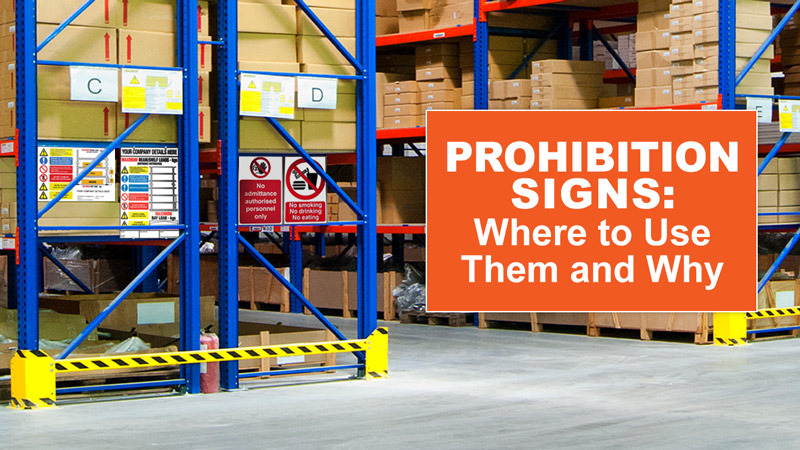Prohibition Signs: Where to Use Them and Why
As the famous rap song says: Stop, Collaborate and Listen! Prohibition Signs are one of the most important Health and Safety features your business requires to keep staff, customers or visitors safe in the workplace. At ESE Direct, we have a wide range of Prohibitions Signs & Labels, which all comply with ISO 7010:2011 legislation. In this blog, we will explore why prohibition signs are so crucial to your workplace well-being.

What are prohibition signs?
A prohibition sign is a type of safety sign prohibiting behaviour likely to increase or cause danger (e.g. 'No Smoking' or 'In The Event Of Fire Do Not Use The Lift'). Safety signs feature clear pictographic illustrations of the hazard they're emphasising, with simple text instructions and an eye-catching visual design.
They are also shaped specifically and colour-coded to make it clear at a glance when an employee is entering a high-risk area or when there are actions they need to take (or actions they should avoid) to safeguard themselves and others. They can be universally understood even if there are language differences. Prohibition signs are essential for health and safety policies and procedures at work.
Why are prohibition signs important?
Failing to understand or implement safety signs in the workplace could have serious implications for employers, staff, and visitors to the premises. The success of any workplace safety intervention often depends on the degree to which managers can communicate the importance of health and safety measures to their staff. The use of prohibition signs is essential for a variety of reasons.
Protecting employees and the public
Depending on the type of workplace, occupational safety hazards could present a risk to members of the public just as much as they do to employees. In certain workplaces, such as construction sites and farms, it’s easy for those passing by to be subject to serious potential dangers. Although, unlike employees, they won’t have the necessary training on these risks and may not know what to do if something goes wrong.
Safety and prohibition signs can help to prevent this by providing warnings to the public of potentially harmful hazards - such as dangerous machinery, loud noises, slippery surfaces, or falling objects. They can also be used to alert civilians of the need to stay clear of certain areas or to provide essential information or contact details of emergency services if they become aware of any signs of danger.
It’s always better to be safe than sorry! Injuries to members of the public are not only traumatic for everyone, but they can also have serious implications for the reputation of your business and legal ramifications. That’s why public-facing prohibition and safety signs can make a major difference.
Highlighting safe work protocols and processes as well as risks
Prohibition signs not only warn workers of hazards; they can also inform them of the most efficient and safest working methods. For instance, they can signal the location of first aid kits, safe exit routes, or instructions on how to safely use machinery or deal with fire risks.
Naturally, those in charge of training staff on health and safety protocols won't always be present for workers who may be new to the environment or need a quick reminder of crucial safety steps. Safety signage and prohibition signs offer staff a simple on-site reference point that is easily accessible and always visible.
Immediate visual transmission of critical safety messages
Workplace health and safety, especially in the more dangerous professions, requires extensive training, rigorous testing or exams, practical demonstrations and regular refresher courses. Safety and prohibition signs aren't intended to replace comprehensive safety training but are important supplements. Many workplaces employ staff members who may not speak English fluently, or work environments may be very noisy, so verbal warnings may be missed. In this case, universally understood visual communication in prohibition signs can quite literally be a lifesaver.
Legal requirements
Installing prohibition and safety signage is a critical element of basic regulatory compliance.
The Health and Safety (Safety Signs and Signals) Regulations Act of 1996 mandates that signs are required where considerable risks to the health and safety of employees and others continue to be present even after all other necessary precautions have been taken. These signs are required to be legible, visibly placed, clear and well-maintained and should be employed in the following situations:
- To highlight procedures and safeguards that must be followed or equipment that must be worn
- To warn against dangerous and prohibited actions in a particular area
- To direct people towards essential safety gear and fire safety equipment
- To draw attention to a nearby hazard or potentially dangerous situation
If companies fail to meet their legal requirements and an accident or incident occurs, they could be at risk of regulatory fines, legal proceedings and, of course, serious reputational harm - which is why no responsible business should ever undervalue or skimp on their prohibition and safety signage investment.
A healthier and happier workforce
According to data from the Health and Safety Executive, more than a million workers become ill or are injured in the UK each year. The total costs linked to workplace injuries and ill health in 2016-17 were estimated at around £15 billion. Workplaces with substandard safety result in reduced productivity and morale and higher absenteeism. However, workplaces that are fully invested in the welfare of their workers allow them to be more efficient and encourage an environment of mutual trust and loyalty.
Prohibition and safety signs are vital and visible contributing factors to a truly effective workplace health and safety culture.
When do you use prohibition signs?
Depending on your specific needs, a wide variety of prohibition signs are available. From the simple and direct "No Entry" sign to prohibit entry into a specific area, to the universally understood and used "No Smoking" sign - which can literally save lives in the case of environments with flammable liquids or gases - we have you covered.
Red signs in workplaces are widely recognised as prohibiting specific actions or entry, and all items in our range are clearly identifiable as such. They are available in self-adhesive vinyl or rigid PVC. Our red signs cover safety prohibitions such as "No exit", "No Entry", "No pedestrians", "No Smoking", "No Unauthorised Vehicles Beyond This Point", and "In the event of fire do not use the lift", as well as many others. We also have an array of Energy Saving Signs (e.g. "Please turn off the light when you leave", "Please turn off all electrical appliances when not in use", etc.)
Here are a few of the most popular prohibitions signs
No mobile phones signs help to ensure staff, customers, and other visitors to your business understand your mobile phone policy throughout your facility.
No parking sign
- Instructs staff, visitors and the public of parking restrictions in force
- Visible and easy-to-understand signs for your workplace
- Ideal for private or business car parks
No smoking sign
- Industry standard no smoking symbol with no smoking text to advise that smoking is not permitted
- Each sign complies with the ISO 7010 legislation for symbols relating to safety signs for accident prevention, fire protection, health hazard information and emergency evacuation
- Available in self-adhesive vinyl or rigid 1mm PVC board
No admittance authorised personnel only sign
- To prevent unwanted persons from accessing areas of restricted access
- Compliant with ISO 7010 legislation for symbols relating to safety signs for accident prevention, fire protection, health hazard information and emergency evacuation
- Manufactured from self-adhesive vinyl or 1mm thick rigid PVC board
- Perfect for mounting on secure storage cages
In the event of a fire do not use lift sign
- Signage advising that in the event of a fire it is not safe to use the lift so use the stairs instead
- ISO 7010 legislation for symbols relating to safety signs for accident prevention, fire protection, health hazard information and emergency evacuation compliant
- Self-adhesive vinyl for sticking on clean flat surfaces or semi-rigid PVC for application using cable ties or industrial glue
No entry sign
- Highly-recognisable no entry image
- Compliant with ISO 7010 legislation for symbols relating to safety signs for accident prevention, fire protection, health hazard information and emergency evacuation
- Choice of rigid signs for application on brick walls or self-adhesive vinyl signs perfect for sticking to a door
Prohibition signs regulations
There are strict rules and regulations regarding prohibition and safety signs. Employers are legally required to provide safety signs if there is a significant risk that cannot be controlled or avoided in any other way, such as through engineering controls or safe systems of work.
Employers must, where necessary:
- explain unfamiliar signs to their employees and tell them what they need to do when they see safety signs
- maintain the safety signs they provide
- use road traffic signs in workplaces to regulate road traffic
You can find out more about safety signage legislation on the Health & Safety Executive website.
So, in conclusion: prohibition signs aren't just a "nice to have" - they're an indispensable component of workplace health and safety.

Author Bio - Debs
Digital marketer, social media, content writer, musician, sloth-lover, tea-drinker.




